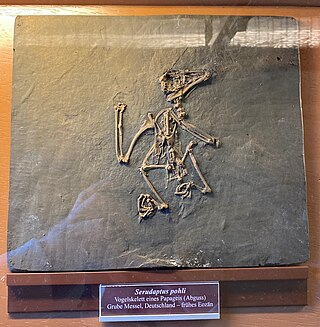
Copepteryx is an extinct genus of flightless bird of the family Plotopteridae, endemic to Japan during the Oligocene living from 28.4 to 23 mya, meaning it existed for approximately 5.4 million years.

Palaeoglaux is a genus of fossil owls from the Eocene epoch. The two known species are P. perrierensis from the Upper Eocene of Quercy, France, and P. artophoron from the Middle Eocene Messel shales, Germany. The holotype of P. perrierensis is a partial left coracoid in the Collection Université Montpellier, accession number PRR 2585. The four paratypes are the distal part of a left humerus (PRR2591), the proximal part of a left ulna, the distal part of a left ulna, and the distal part of a right tarsometatarsus. The type specimen of P. artophoron is a fossil slab and counterslab containing most of the postcranial skeleton and some feather impressions. This specimen is in the collection of the Forschunginstitut Senckenberg, accession number SMF-ME 1144 A and B.
Eurofluvioviridavis is a genus of extinct primitive birds from the Middle Eocene Messel Pit, Germany. It contains a single species, Eurofluvioviridavis robustipes. It is related to Avolatavis and Vastanavis, other members of the family Vastanavidae.

Hokkaidornis is an extinct genus of penguin-like plotopterid from the Late Oligocene of Hokkaido, Japan.
Kupoupou is an extinct genus of bird from the Paleocene-aged Takatika Grit of the Chatham Islands, New Zealand which is believed to be the oldest penguin genus known to date. The type species, K. stilwelli, was named and described by Blokland et al. in 2019.
Danielsraptor is an extinct genus of masillaraptorid bird from the Early Eocene (Ypresian) Walton Member of the London Clay Formation in Essex, United Kingdom. The genus contains a single species, D. phorusrhacoides, known from a partial skeleton.
Nasidytes is an extinct genus of loon (Gaviiformes) that lived during the early Eocene in what is now Great Britain. It contains a single species, N. ypresianus. Nasidytes is the earliest unambiguously identified loon in the fossil record.

Tonsala is an extinct genus of Plotopteridae, a family of flightless seabird similar in biology with penguins, but more closely related to modern cormorants. The genus is known from terrains dated from the Late Oligocene of the State of Washington and Japan.
Pliolymbus is a fossil genus of grebe known from the Late Pliocene to Early Pleistocene of United States and Mexico. It is known from a single species, P. baryosteus.

Ypresiglaux is an extinct genus of strigiform bird from the Early Eocene London Clay Formation of Essex, United Kingdom and Nanjemoy Formation of Virginia, United States. The genus contains two species: Y. michaeldanielsi, known from a partial skeleton, and Y. gulottai, known from a distal tarsometatarsus.

Lutavis is an extinct genus of potentially afroavian bird from the Early Eocene London Clay Formation of Essex, United Kingdom. The genus contains a single species, L. platypelvis, known from a partial skeleton.

Psittacomimus is an extinct genus of psittacopedid bird from the Early Eocene London Clay Formation of Essex, United Kingdom. The genus contains a single species, P. eos, known from a partial skeleton.

Minutornis is an extinct genus of parapasserine bird from the Early Eocene London Clay Formation of Essex, United Kingdom. The genus contains a single species, M. primoscenoides, known from a fragmentary skeleton.

Klallamornis is an extinct genus of Plotopteridae, a family of large, flightless birds related to modern cormorants, darters, gannets, and boobies. This genus included the largest North American plotopterids. Its remains can be found in Late Eocene to Late Oligocene rocks from the Makah Formation, the overlying Pysht Formation and the Lincoln Creek Formation of the State of Washington. During its existence, Klallamornis was the largest plotopterid on the North American continent. The first fossil remains attributed to the taxon were collected in 1983, although the genus wasn't described until 2016.
Charadriisimilis is an extinct genus of charadriiform birds from the Early Eocene (Ypresian) London Clay of Walton-on-the-Naze, United Kingdom. The genus contains a single species, Charadriisimilis essexensis, known from partial postcranial remains.
Pulchrapollia is an extinct genus of halcyornithid bird from the Early Eocene London Clay of Walton-on-the-Naze, United Kingdom and the Nanjemoy Formation of Virginia, United States. The genus contains three species, Pulchrapollia gracilis, Pulchrapollia tenuipes and Pulchrapollia eximia.

Serudaptus is an extinct genus of halcyornithid bird from the Middle Eocene Messel pit in Hesse, Germany. The genus contains one species, Serudaptus pohli, and is known for long, raptorial claws on its zygodactyl feet.
Parapsittacopes is an extinct genus of psittacopedid bird from the Early Eocene London Clay, United Kingdom. The genus contains one species, Parapsittacopes bergdahli.
Eofringillirostrum is an extinct species of bird known from the Early Eocene Green River Formation of the Western United States and from the Messel Pit in Germany. The genus contains two species, Eofringillirostrum boudreauxi and Eofringillirostrum parvulum. They are the earliest known fossil birds to have a finch-like beak.
Sororavis is an extinct genus of bird from the Early Eocene London Clay of Walton-on-the-Naze, United Kingdom. It contains a single named species, Sororavis solitarius. It is a member of the Morsoravidae.






















